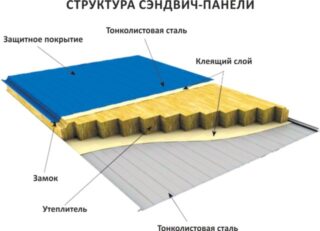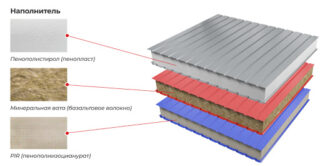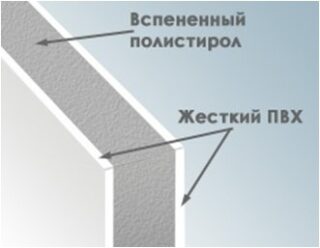Houses made of sandwich panels are erected at any time of the year in a few days. The walls do not let the cold in in winter, heat in summer. The cost of such a building is significantly lower than brickwork and concrete blocks. Construction will be even cheaper if you make your own sandwich panels.
DIY sandwich panels at home
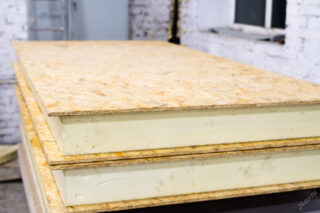
The simple design of multi-layer slabs allows you to make DIY wall sandwiches. The difficulty lies in the acquisition of special equipment. For the assembly of the panel, a table is used in size exceeding the dimensions of the outer layers. Strong adhesion is only possible under a press. Speed plays a decisive role in obtaining quality building material.
The manufacturing technology of thermoplates is simple, but it has many nuances that you need to know. Any violation of the rules will not allow making the sandwich strong, durable and beautiful.
You should start with the preparation of the workplace, the selection of materials, their cutting and cleaning of dust.
Layer composition
The thickness of the thermal insulator is calculated based on the characteristics of the material and the weather conditions in the region. The stronger the frosts in winter, the thicker the walls should be.
Exterior finish is chosen at the request of the developer. Each material has its own strengths and weaknesses.
The sandwich contains glue. Only one brand can be used for home making.
The advantage of making sandwich panels with your own hands is individual sizes. The height and thickness of the walls are made not according to standard standardized dimensions, but at the request of the builder.
Types of used thermal insulation materials
- mineral wool;
- polyurethane foam;
- expanded polystyrene.
Mineral wool is used more often than others. It does not burn, does not absorb moisture, and is durable. It is made from different materials. The technical characteristics differ little.
Fiberglass is cheaper than other types of mineral wool, but will last less. After a few years, the condensate formed in it will begin to freeze and destroy the fibers.
Basalt insulation consists of molten stone fibers. It is more expensive than other types of mineral wool and significantly surpasses them in strength and durability. The walls are guaranteed not to collapse for at least 50 years. Thermal insulation performance is higher than other materials. Water repels. No condensation will form.
Polyurethane foam has a low specific weight and does not require a solid foundation. It is dense, reinforces the panels. Suitable for construction in swampy soils and areas with high humidity. Melts when burning, emitting harmful gases.
Expanded polystyrene is lightweight, cheap. The main disadvantage is that it supports combustion.
Polyfoam as insulation is used for the construction of warehouses, garages, and utility rooms. They rarely put in residential buildings.
What can be used for enclosing layers
The enclosing layer must be strong and tough.It ensures the correct panel geometry.
Depending on the material of the shell included in the sandwich, panels are distinguished: SIP, PVC, metal.
SIP
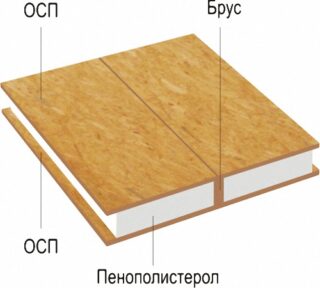
SIP sandwich has a shell of chipboard - chipboard, fiberboard, particle board, etc. Their structure consists of wood chips, sawdust, shavings. Compressed wood waste is glued together under pressure with various adhesives. More often than others, they are used in the self-production of sandwiches.
Advantages of using wood-based panels as enclosing layers:
- natural natural material;
- additional heat and noise insulator;
- cut with a simple hacksaw and grinder;
- easy to cut, slopes are cut from them;
- does not emit harmful substances.
The disadvantages include:
- fast ignition in case of fire;
- absorb moisture;
- warp when wet.
SIP panels require constant care, coverings with compounds that protect against moisture and sunlight. Additionally, it is necessary to provide protection against fire.
Pvc
The weak point of plastic is that any of its varieties is destroyed by exposure to sunlight. Experts recommend taking plastic sheets with a protective coating, which is decorative at the same time, for the outer fencing. After 10 years, the walls will have to be covered with protective varnish or paint every 3-4 years.
Metal
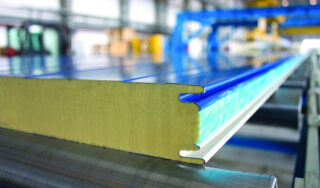
For the manufacture of metal panels used:
- galvanized metal sheet;
- corrugated board;
- professional sheet;
- aluminum sheet products.
The material is characterized by high hardness and strength, high specific gravity, moisture resistance. Making sandwich panels with your own hands is not possible without a special cutting tool. Sandwich panels are guaranteed to last over 50 years.
Galvanized sheet is cheaper than others. Its disadvantages:
- zinc is harmful to health;
- after 5 years, the coating will come off, and corrosion spots will begin to form;
- unsightly appearance;
- complex cutting with a special tool.
The profile sheet has a protective coating over the zinc layer and a decorative painted or laminated layer. Outside, the panels are reliably protected.
The aluminum sheet will remain intact even after several decades of use. It will outlive any heat insulator. Soft, lightweight, durable metal is easily cut with roller shears and a grinder. The resulting burrs are easily removed. The disadvantage of aluminum sheet is the high price.
The adhesive must provide the desired adhesion and durability. Two-component has a high solidification rate. Used on automatic lines. One-component is used for semi-automatic and manual sandwich making.
Manufacturing technology
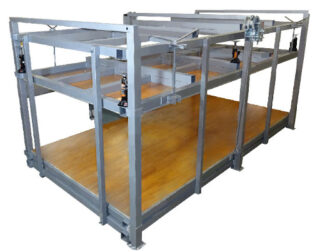
Any type of self-made panels is assembled using the same technology. Layers are collected on a table that is larger than the panel. Then everything is squeezed under a press so that the glue does not foam and the rest of the materials take the desired shape.
First, you need to clean all surfaces from dust and dirt, check that there are no wet and oil stains. Heat blocks are made in batches of 4-6 pieces.
Operating procedure:
- Put the bottom cover on the table - the inner side of the panel.
- Lubricate it with glue.
- Put insulation on top.
- Apply glue.
- Install the outer covering layer.
- Transfer quickly to the press.
All work must be done in a maximum of 5 minutes. Glue the following sandwiches without interruption.
Having collected a stack of plates up to 1.2 m high, press it from above with a press with a force of about 18 tons and hold it for 2-4 hours.
Compression is required due to the nature of the adhesive. It crystallizes when combined with moisture and air and foams to form an uneven layer. It freezes in 30 minutes. The press compresses all layers, so the homemade wall material cannot change shape.
The press can be replaced with other devices, for example, put a flat plate on top and load it quickly.

